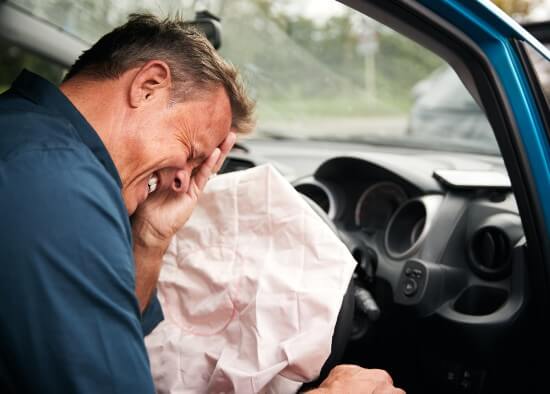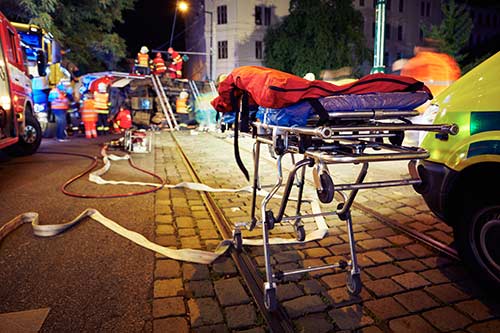It is illegal for a driver to leave the scene of an accident without first rendering aid or leaving contact information for the owner of the car that was struck. Nevertheless, countless people floor it after striking a pedestrian or vehicle, and the majority probably never get caught.

At the Ladah law firm, we realize how upsetting it can be to experience or witness a hit and run. The legal system only functions if people take responsibility for their actions. Choosing to high-tail it away from a crime scene is the very opposite of taking responsibility. Fortunately, there are steps that victims can take that improve the odds of the offending driver being caught. If you have questions, please contact our personal injury lawyers in Las Vegas for more information.
The Legal Duty to Stop and Render Assistance
Multiple laws lay out the steps a driver must take after getting into an accident. For example, Nevada Revised Statute 484E.020 states that a motorist must “immediately” stop their car at the scene of the accident. If the car creates an obstruction or hazard, the driver can move it safely out of the way—but they need to stop.
NRS 484E.030 also requires that drivers provide personal information when they injure or kill a person in the wreck. Personal information includes their name and address, along with their registration number. If requested, they must also show their driver’s license.
Motorists must also help anyone injured obtain medical assistance. This can include calling an ambulance or taking them to the hospital.
When a motorist hits an unattended vehicle or other property, NRS 484E.040 requires that the driver immediately stop and find the property owner. When the owner cannot be located, the driver should leave their personal information in an obvious place.
Penalties for leaving the scene of an accident are steep. When there is only property damage, a person faces misdemeanor charges and up to 6 months in jail, along with up to $1,000 fine and six demerit points added to their license.
If somebody was injured or killed, however, then a driver can be charged with a felony. Penalties include up to 20 years in prison and $5,000 in fines, along with demerit points.
Why You Should Call the Police
If you witnessed a hit and run, or if you were struck, you should immediately call the police provided you are able. The police will come to the scene and write a police report, which your insurer will find useful.
Furthermore, the police can also search for the suspect involved in the crash. If there was only property damage, the police might not be as aggressive finding the suspect as when there is a bodily injury. Nevertheless, you still must report accidents to law enforcement.
Share Details about the Hit & Run Driver
- Any details you have are helpful for the police. We recommend sharing as much of the following as you can:
- The make and model of the car
- The car’s color
- Any bumper stickers or distinguishing features (such as a burned-out taillight)
- The license plate number (or as much as you remember)
- A description of the driver (such as gender, race, hair style, etc.)
- The direction the car fled in
Police can use this information to put out a bulletin. Members of the public who see the car can then contact the police, who will investigate. If someone was injured or died in the crash, police should vigorously pursue the perpetrator, who can face serious criminal charges.
Obtain Medical Care

Some hit and runs cause terrible injuries. You might have been struck while crossing the street or getting out of your car, so you might need immediate medical assistance. Ask someone to call emergency services for you if you are too badly hurt to call.
If you witnessed an accident, ask anyone in the car if they need an ambulance. You can call for them and then wait for it to arrive to tend to the victims.
Why You Shouldn’t Chase the Driver
You might be tempted to give chase and apprehend the suspect yourself. This is a serious mistake! For one thing, you don’t want to take any action that is illegal, such as speeding or swerving in traffic. There is no reason to break the law, and chances are low that you will even catch the fleeing suspect.
For another thing, a driver who thinks he is being chased will engage in more aggressive driving to get away. This means the driver could get into a second wreck. It is very possible that giving chase will only lead to more people getting hurt. Instead, use the precious seconds before the driver speeds away to memorize the license plate or the color of the car.
Take Pictures at the Scene Instead
- You should take pictures with your phone of anything that will prove helpful to an insurance adjuster trying to reconstruct the accident. For example, you can get pictures of:
- Damage to your vehicle
- Skid marks on the road
- Anything the fleeing driver struck (such as another car or utility pole)
Once you go to the hospital, you can also take pictures of your injuries, such as lacerations, abrasions, cuts, and bruises. Make the pictures as vivid as you can—and remember not to smile when taking a picture of your face.
Get Witness Information
Witnesses might have seen more of the car or the driver than you did. If so, they can provide this critical information to the police, thereby helping to locate the fleeing suspect.
Witnesses might also play a role in making an insurance claim. A person’s uninsured motorist coverage will often cover a hit-and-run collision. But there is a key limitation—the victim cannot be to blame for the accident.
Sometimes, with hit-and-run accidents, the insurance company is not fully convinced that the victim is blameless. They might even suspect that their insured caused the accident themselves, perhaps by driving off the road after falling asleep or by being intoxicated.
Witnesses can help establish that you truly were the victim of a hit and run. Try to get each witness’ name and contact information. The insurance adjuster might want to talk to them. Although the police officer should identify any witnesses, folks often leave the scene before the officer arrives. Better to get the information than to be sorry that you missed them.
Contact Your Insurance Company
If you were struck by a hit-and-run driver, you should contact your insurer as soon as possible. Don’t wait longer than 24 hours unless you are incapacitated in the hospital. Tell your insurer you were involved in a hit and run crash and provide the time, date, and location. Your insurer will want to know if you called the police, so share that information as well. Reporting the accident promptly is vital to receiving as much compensation as possible following the collision.
We Can Help with Hit and Run Accidents
Not all insurance companies are eager to pay compensation following a hit and run. You might hit a wall trying to get your claim taken seriously, or the insurer could minimize your injuries. This is a stressful time, and many of our clients need compensation as soon as possible.
For assistance, please contact Ladah Law today. We offer a free consultation, which you can schedule if you call 702-252-0055 or send us an online message.
